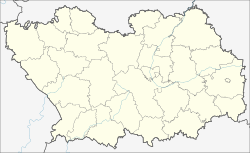Noronshasht (Moksha: νορονςαςτ, romanized: Noronshasht, lit. 'IPA ['noronʲʃɑʃtʲ]', Arabic:كبير IPA ['ka.biːr])[4]) was the large trade hub on the Silk Road and capital city of Moxel in 1230-1237. It was the administrative center of Murunza and one of the centres of coinage. In 1237 century the city was taken over by Batu Khan and became the capital of the Golden Horde. The ruins (buildings of stone, fortifications, Pagan cemetery) are in Penza Oblast near the modern town of Narovchat in the confluence of Sheldais and Moksha River.
νορονσαστ, Noronshasht IPA [,noronʲ'ʃɑʃtʲ] | |
 Kabeer on Al-Idrisi World map 804/1154 A.D. | |
| Alternative name | Arabic:كبير IPA ['ka.biːr][3] |
|---|---|
| Location | Penza Oblast, Russia |
| Region | Moxel |
| Coordinates | 53°50′57″N 43°44′15″E / 53.8493°N 43.7374°E[1][2] |
| Type | Cultural |
| Length | 2000 |
| Width | 900 |
| History | |
| Material | stone |
| Founded | before 7th c AD |
| Abandoned | 1600s |
| Periods | Early Middle Ages |
| Cultures | Saltovo-Mayaki |
| Satellite of | Khazar Khaganate (since 8th c.) |
| Events | Mongol Takeover in 1237 |
| Site notes | |
| Excavation dates | 1923-1927 |
| Archaeologists | Aleksandr Krotkov |
| Condition | In ruins |
| Management | Penza Oblast Authority |
| Website | museum-nar.penz.muzkult.ru |

Foundation and etymology edit
The city foundation date is unknown. The archeological findings confirmed the first city population was Moksha.[5] According to Iosif Cherapkin the ancient name of the city was Noronshasht in Middle Moksha means 'former bog place covered with grass'.[6] The city lay in a lowland on a former bog place. First mention of the city is al-Idrisi's map under the name Kabir (Great) in early version of 1154.[7] After 13th c he city was often referred to as Mukhsha or Mukhshi which in fact was the name of the ulus Mukhsha of the Golden Horde (after the name of Mokshaland), the official city name used in the Mongol period was Nurinjat [a].[8][9]
History edit
Noronshasht was the capital of Medieval Moksha kingdom Murunza.[10] Russian Laurentian Codex mentions the name of its king Puresh.[11] Noronshasht was conquered by Batu Khan in 1237. In ancient period attested private and public baths, running water, sewerage, underfloor heating. The streets were paved with stones, there were fountains with drinking water, inns, royal palace, houses of stone. There were potteries with ancient forges. There was an artisan quarter with numerous workshops. Residential quarters partly lay nowadays under the rural locality Narovchat. Northwest of Narovchat lays the gravefield (Pagan cemetery)[12][13]
Coinage edit
Yarmaq still means money in contemporary Moksha language[14] and shelegs might be minted in Noronshasht as well.[15]
Other coins names were valf[b], oka (gold), variaftom ([c], variavne [d], and sere/serene[e].[16]
Architecture edit
Moksha lions edit
Ethnologists and historians state that there is a connection between Mokshaland animal style archeological findings and early Russian reliefs especially so called "smiling lions" in inner decor of Cathedral of Saint Demetrius in Vladimir. They believe similar "Mokshan lions" might have preserved in Ancient Noronshasht and Sernya stone buildings if the cities had not been destroyed in Middle ages. The animal style dates back to Scythian art and prominent for Saltovo-Mayaki culture. Schapov explains this by the fact that brother of Andrew the Pious Vsevolod the Big Nest had married to Russian: ясыня, romanized: yasinya, lit. 'Alanian' princess Maria (Shvarnovna). Artisans who performed this unique for Russia style came together with her and they were Alans who share Animal style with Mokshas[17][18] Larionov also mentions animal style in Church of the Intercession on the Nerl of Andrew the Pious and Cathedral of the Nativity in Suzdal.[19]
Discovery and Excavations edit
The Medieval city ruins were discovered by Russian archeologist Aleksandr Krotkov in 1915.
Museum-reserve edit
See also edit
References edit
- ^ Lebedev 1958, pp. 11, 16, 19
- ^ Ikonnikov & Baisheva 2018
- ^ Madurov 2012
- ^ Lebedev 1957
- ^ Lebedev 1957
- ^ Krotkov 1923
- ^ Madurov 2012
- ^ Lebedev 1957
- ^ Lebedev 1958
- ^ Карамзин Н. М. История государства Российского: в 12 томах. — СПб.: Тип. Н. Греча, 1816—1829
- ^ Laurentian Codex, 1377, Russian National Library, Saint-Petersburg
- ^ Krotkov 1923
- ^ Ikonnikov & Baisheva 2018
- ^ Serebrenikov, Feoktistov & Polyakov 1998
- ^ Golubev 2020
- ^ Cherapkin 1929, p. 14
- ^ Schapov 2013, pp. 16–17
- ^ Larionov 2019
- ^ Larionov 2019.
Notes edit
Footnotes edit
Sources edit
- Krotkov, Aleksandr (1923), In Search Of Mukhshi. Saratov University History, Archeology and Ethnography Society (in Russian), Saratov
{{citation}}: CS1 maint: location missing publisher (link) - Lebedev, Vitaly (1957), Mysterious City Mokhshi (in Russian), Penza
{{citation}}: CS1 maint: location missing publisher (link) - Lebedev, Vitaly (1958), Excavations Description. Archeologist Vitaly Lebedev's works (in Russian), Penza
{{citation}}: CS1 maint: location missing publisher (link) - Ikonnikov, Dmitry; Baisheva, Marina (2018), "Golden Horde City Mokhshi Topography in 13-14th Centuries", Вестник Пензенского Государственного Университета (in Russian), 1 (21), Penza State University Review: 82–90
- Madurov, Dmitry (2012), "Great City" Localization In The Light Of 1184 Events Reconstruction. Statehood Of East Bulghars between 9th and 13th centuries (in Russian), Cheboksary: Taus
- Schapov, V.A. (2013), Clan Symbol (in Russian), Penza
{{citation}}: CS1 maint: location missing publisher (link) - Larionov, Vladimir (2019). From The Second Jerusalem To The Third Rome. Sacred Tstardom Symbols. Ideocratic Paradigm Genesis In Russian Culture in between 11th and 13th centuries (in Russian). Litres. ISBN 978-5041862824.
- Serebrenikov, B.A.; Feoktistov, A.P.; Polyakov, O.Y., eds. (1998) [First published 1998]. Moksha-Russian Dictionary (in Russian). Digora. ISBN 5-200-02012-3.
- Golubev, O.V. (2020), Mokhshi Coinage (in Russian), Penza: Sokolov Publishing
- Kamola, Stefan (2019). Making Mongol History: Rashid al-Din and the Jamiʿ al-Tawarikh (Edinburgh Studies in Classical Islamic History and Culture). Edinburgh: Edinburgh University Press. ISBN 978-1474421423.
- Cherapkin, Iosif (1929). "Mokshoks Yarmak Lepne [Currency terms in Mokshan]". Valda Yan (in Moksha). Saransk.

